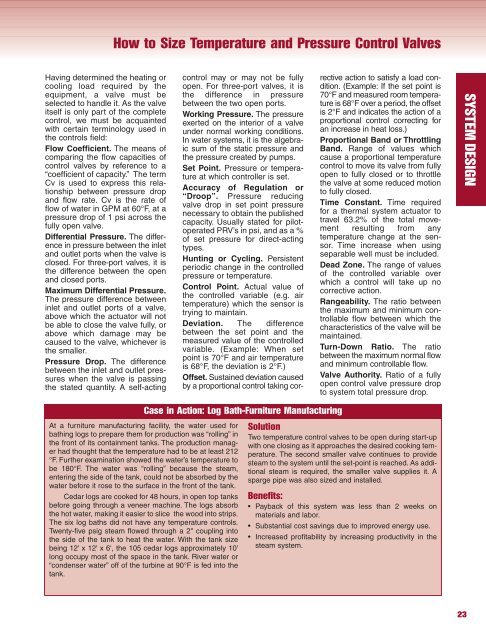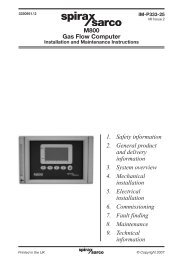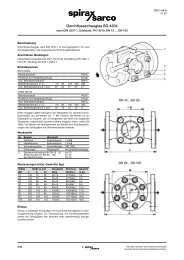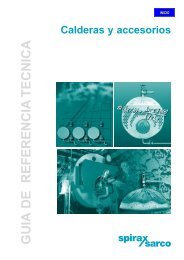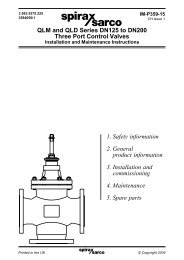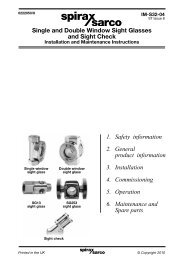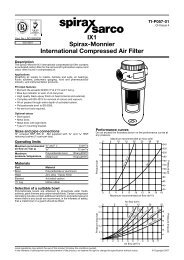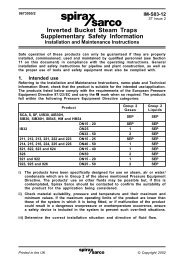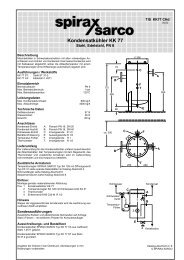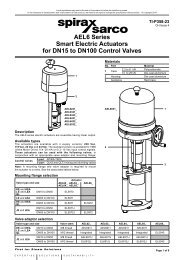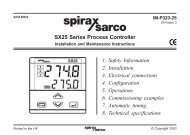2000 Hook-up Book - Spirax Sarco
2000 Hook-up Book - Spirax Sarco
2000 Hook-up Book - Spirax Sarco
You also want an ePaper? Increase the reach of your titles
YUMPU automatically turns print PDFs into web optimized ePapers that Google loves.
Having determined the heating or<br />
cooling load required by the<br />
equipment, a valve must be<br />
selected to handle it. As the valve<br />
itself is only part of the complete<br />
control, we must be acquainted<br />
with certain terminology used in<br />
the controls field:<br />
Flow Coefficient. The means of<br />
comparing the flow capacities of<br />
control valves by reference to a<br />
“coefficient of capacity.” The term<br />
Cv is used to express this relationship<br />
between pressure drop<br />
and flow rate. Cv is the rate of<br />
flow of water in GPM at 60°F, at a<br />
pressure drop of 1 psi across the<br />
fully open valve.<br />
Differential Pressure. The difference<br />
in pressure between the inlet<br />
and outlet ports when the valve is<br />
closed. For three-port valves, it is<br />
the difference between the open<br />
and closed ports.<br />
Maximum Differential Pressure.<br />
The pressure difference between<br />
inlet and outlet ports of a valve,<br />
above which the actuator will not<br />
be able to close the valve fully, or<br />
above which damage may be<br />
caused to the valve, whichever is<br />
the smaller.<br />
Pressure Drop. The difference<br />
between the inlet and outlet pressures<br />
when the valve is passing<br />
the stated quantity. A self-acting<br />
How to Size Temperature and Pressure Control Valves<br />
At a furniture manufacturing facility, the water used for<br />
bathing logs to prepare them for production was “rolling” in<br />
the front of its containment tanks. The production manager<br />
had thought that the temperature had to be at least 212<br />
°F. Further examination showed the water’s temperature to<br />
be 180°F. The water was “rolling” because the steam,<br />
entering the side of the tank, could not be absorbed by the<br />
water before it rose to the surface in the front of the tank.<br />
Cedar logs are cooked for 48 hours, in open top tanks<br />
before going through a veneer machine. The logs absorb<br />
the hot water, making it easier to slice the wood into strips.<br />
The six log baths did not have any temperature controls.<br />
Twenty-five psig steam flowed through a 2" co<strong>up</strong>ling into<br />
the side of the tank to heat the water. With the tank size<br />
being 12' x 12' x 6', the 105 cedar logs approximately 10'<br />
long occ<strong>up</strong>y most of the space in the tank. River water or<br />
“condenser water” off of the turbine at 90°F is fed into the<br />
tank.<br />
control may or may not be fully<br />
open. For three-port valves, it is<br />
the difference in pressure<br />
between the two open ports.<br />
Working Pressure. The pressure<br />
exerted on the interior of a valve<br />
under normal working conditions.<br />
In water systems, it is the algebraic<br />
sum of the static pressure and<br />
the pressure created by pumps.<br />
Set Point. Pressure or temperature<br />
at which controller is set.<br />
Accuracy of Regulation or<br />
“Droop”. Pressure reducing<br />
valve drop in set point pressure<br />
necessary to obtain the published<br />
capacity. Usually stated for pilotoperated<br />
PRV’s in psi, and as a %<br />
of set pressure for direct-acting<br />
types.<br />
Hunting or Cycling. Persistent<br />
periodic change in the controlled<br />
pressure or temperature.<br />
Control Point. Actual value of<br />
the controlled variable (e.g. air<br />
temperature) which the sensor is<br />
trying to maintain.<br />
Deviation. The difference<br />
between the set point and the<br />
measured value of the controlled<br />
variable. (Example: When set<br />
point is 70°F and air temperature<br />
is 68°F, the deviation is 2°F.)<br />
Offset. Sustained deviation caused<br />
by a proportional control taking cor-<br />
Case in Action: Log Bath-Furniture Manufacturing<br />
rective action to satisfy a load condition.<br />
(Example: If the set point is<br />
70°F and measured room temperature<br />
is 68°F over a period, the offset<br />
is 2°F and indicates the action of a<br />
proportional control correcting for<br />
an increase in heat loss.)<br />
Proportional Band or Throttling<br />
Band. Range of values which<br />
cause a proportional temperature<br />
control to move its valve from fully<br />
open to fully closed or to throttle<br />
the valve at some reduced motion<br />
to fully closed.<br />
Time Constant. Time required<br />
for a thermal system actuator to<br />
travel 63.2% of the total movement<br />
resulting from any<br />
temperature change at the sensor.<br />
Time increase when using<br />
separable well must be included.<br />
Dead Zone. The range of values<br />
of the controlled variable over<br />
which a control will take <strong>up</strong> no<br />
corrective action.<br />
Rangeability. The ratio between<br />
the maximum and minimum controllable<br />
flow between which the<br />
characteristics of the valve will be<br />
maintained.<br />
Turn-Down Ratio. The ratio<br />
between the maximum normal flow<br />
and minimum controllable flow.<br />
Valve Authority. Ratio of a fully<br />
open control valve pressure drop<br />
to system total pressure drop.<br />
Solution<br />
Two temperature control valves to be open during start-<strong>up</strong><br />
with one closing as it approaches the desired cooking temperature.<br />
The second smaller valve continues to provide<br />
steam to the system until the set-point is reached. As additional<br />
steam is required, the smaller valve s<strong>up</strong>plies it. A<br />
sparge pipe was also sized and installed.<br />
Benefits:<br />
• Payback of this system was less than 2 weeks on<br />
materials and labor.<br />
• Substantial cost savings due to improved energy use.<br />
• Increased profitability by increasing productivity in the<br />
steam system.<br />
23<br />
SYSTEM DESIGN


